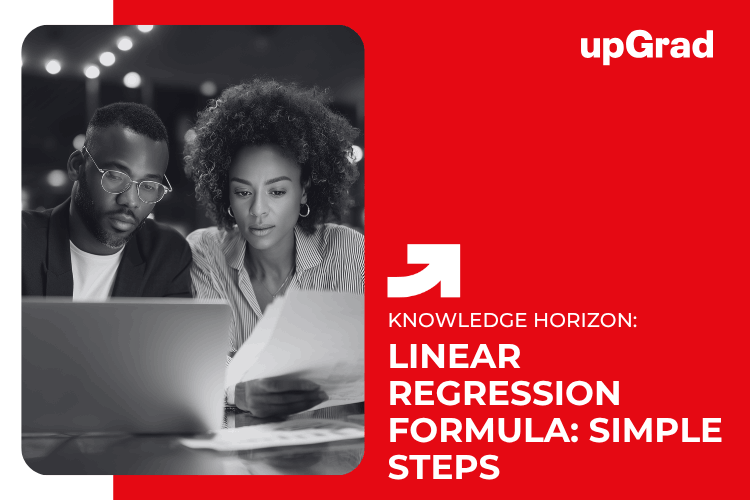Linear regression is among the simplest and best machine learning approaches. It calculates the value of a dependent variable based on one or more independent factors. In this article, understand the linear regression formula in detail as we break it down into steps.
Linear Regression Equation
In terms of mathematics, the linear regression equation is a simple one. Below is the formula, followed by an explanation of what each of the formula’s variables means:
| Linear Regression Formula = y = a + bx |
Here,
- (y) is Dependent Variable: This variable depends on the other measured variables to the right of the equals sign.
- (a) is Regression Intercept Term: The point at which the function crosses the y-axis, or the constant amount of the dependent variable when the independent variable x is set to zero.
- (b) is Regression Slope Coefficient: The variation in the independent x variable for a unit shift in the independent y variable that establishes the slope of the line.
- (x) is an Independent Variable: The variable used to forecast the value of another variable; x is also known as the predictor since it is utilised to forecast the value of the dependent variable.

Using The Linear Regression Formula In Excel
Besides Excel, you can perform multiple linear regression with other spreadsheet programs, like Google Sheets or Zoho Sheets. Although the procedures differ, they are essentially the same.
When it comes to linear regression vs logistic regression, the latter is simple. However, they could be difficult to perform in old Excel versions. However, with the inclusion of sophisticated data analysis capabilities in more recent versions, linear regressions become simple to perform.
Also Read: Regression Analysis: Meaning, Applications, and Business Implications
Step 1: Fill Excel with Historical Values
Enter your history data into Excel first.
Step 2: Use A Scatter Plot To Plot Your Historical Data
- Next, use a scatter plot to visualise your historical data.
- Choose every data-filled field, including the header labels.
- On the menu at the top, select the “Insert” tab.
- After selecting “Scatter,” choose “Scatter with only Markers,” which is the first option.
A highly consistent linear association exists between the variables even before the trendline is placed.
Step 3: Position the Trendline
- To finish your linear regression, the trendline must be drawn against your scatter plot.
- Choose “Add Trendline” from the scatter plot chart with a right-click.
- Click on the Format tab and select “Linear.”
- Enable “Display Equation on Chart” and “Display R-squared value on chart” by checking the corresponding boxes.
The results—listed below—are positioned inside the chart because you chose to show the R-squared value and the linear regression equation.
Also Read: Statistical Tools Used in Research Methodology: A Comprehensive Guide
Step 4: Compute Your Prediction
You may now forecast the sales figure using this equation by entering a value for x.
- In the equation y = a + bx, substitute x.
- Find y by solving the equation.
The coefficient of determination, or R² value, shows how well your data matches the regression model (goodness of fit). R2 is usually best when it is 0.9 or higher.
Conclusion
Although Excel is an excellent tool for making presentations, reporting, and visualising data, its data modelling capabilities are a little bit limited. To use the linear regression equation faster and better, you must have data analysis skills in Excel. For professional learning, enrol in the best data analytics program from UpGrad to learn how to use data analysis skills in Excel to compute linear regression effortlessly.
Explore the following Data Science programs through upGrad to get the best experience in formal education:
- Master of Science in Data Science – Liverpool John Moores University
- Post Graduate Diploma in Data Science (E-Learning) – upGrad Institute
- Executive Diploma in Data Science and AI -IIT Bangalore
- Post Graduate Certificate in Data Science & AI (Executive) – IIT Bangalore
For more information, email at query@upgrad.com or call +65-6232-6730
FAQs
1. When should I apply a linear regression formula?
When a linear link between your dataset’s independent and dependent variables is seen, you should apply a linear regression formula. Additionally, if your data meets the abovementioned requirements, linear regression is the best option for predicting a continuous result.
2. Which is the best place to learn data analytics for linear regression?
If you want to gain data analysis skills to simplify linear regression functions in Excel, enrol in one of the data analytics courses from UpGrad.








